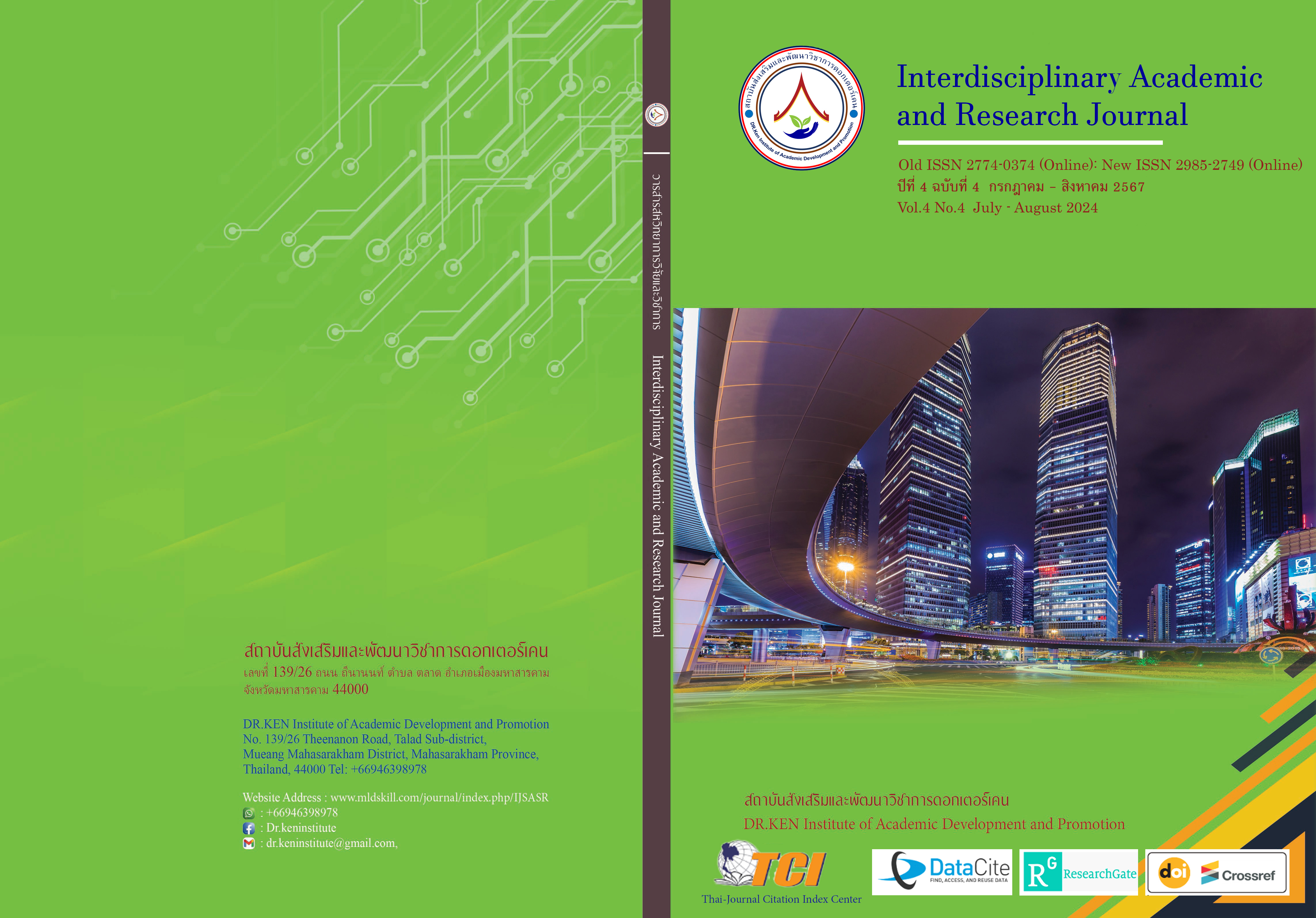The Effect of Organizing Learning Activities Using the KWDL Technique to Improve the Math Achievement of 3 Grade Students
DOI:
https://doi.org/10.60027/iarj.2024.277045Keywords:
Kwdl Learning Activities Technique;, Mathematics Learning AchievementAbstract
Background and Aims: Mathematics enables humans to be creative, think logically, systematically, and methodically, and be able to analyze problems or situations carefully and thoroughly. Moreover, mathematics helps students predict, plan, and make decisions to solve problems correctly and appropriately. This research aimed to 1) compare the mathematics learning achievement after studying of grade 3 students with the criterion of 70 percent and 2) compare the mathematics learning achievement of grade 3 students before and after learning.
Methodology: This research is quantitative and employs a quasi-experimental research design. One group of subjects in the study comprised 26 third-grade students from the 2022 academic year at the Demonstration School of Valaya Alongkorn Rajabhat University under the Royal Patronage in Pathum Thani Province. The selection was conducted using cluster random sampling. The employed research instruments consisted of 1) mathematics learning management plans on problems regarding addition, subtraction, multiplication, and division by using activities management according to the KWDL Technique, 4 plans, 16 hours, and 2) a mathematics learning achievement test, 30 items. The data analysis employed statistics including percentage, mean, and standard deviation. Hypothesis testing was conducted using a dependent t-test.
Results: The results show that 1) the mathematics learning achievement of Grade 3 students after receiving learning activities using the KWDL technique had an average mathematics learning achievement score of 73.86 percent, which is higher than the specified criteria of 70 percent. and 2) The mathematics learning achievement of Grade 3 students increased significantly after engaging in learning activities using the KWDL technique, compared to their performance before the learning activities, with a statistically significant difference at the .05 level.
Conclusion: The KWDL technique effectively enhances the math achievement of the sample students by guiding them through a sequential and well-structured learning process. This approach results in higher math achievement scores post-test compared to predefined criteria.
References
กระทรวงศึกษาธิการ. (2560). ตัวชี้วัดและสาระการเรียนรู้แกนกลางกลุ่มสาระการเรียนรู้คณิตศาสตร์ (ฉบับปรับปรุง พ.ศ. 2560) ตามหลักสูตรแกนกลางการศึกษาขั้นพื้นฐานพุทธศักราช 2551. กรุงเทพมหานคร : โรงพิมพ์ชุมนุมสหกรณ์การเกษตรแห่งประเทศไทย จำกัด.
จิตรลัดดา นุ่นสกุล. (2555). ครูในอนาคตแห่งศตวรรษที่21. Retrieved on 22 March 2020: https://www.gotoknow.org/posts/494489
น้ำทิพย์ ชังเกตุ. (2547). การพัฒนาผลการเรียนรู้เรื่องโจทย์ปัญหาการคูณของนักเรียนชั้นประถมศึกษาปีที่ 4 โดยจัดการเรียนรู้แบบร่วมมือกับเทคนิค STAD ร่วมกับเทคนิค KWDL. วิทยานิพนธ์ศึกษาศาสตรมหาบัณฑิต: มหาวิทยาลัยศิลปากร.
นิรันดร์ แสงกุหลาบ. (2547). การเปรียบเทียบผลการเรียนรู้เรื่องโจทย์ปัญหาทศนิยมและร้อยละของนักเรียนชั้นประถมศึกษาปีที่ 5 ที่จัดการเรียนรู้ด้วยเทคนิค KWDL และตามแนว สสวท. วิทยานิพนธ์ปริญญาศึกษาศาสตรมหาบัณฑิต: มหาวิทยาลัยศิลปากร.
บุญชม ศรีสะอาด. (2558). การวิจัยเบื้องต้น. กรุงเทพ : บริษัท สุวีริยาสาส์น จำกัด.
ปรียาณ์ภัสนากร สุ่มมาตย์. (2562). การพัฒนากิจกรรมการเรียนรู้คณิตศาสตร์โดยใช้เทคนิค KWDL เพื่อส่งเสริมความสามารถในการแก้ปัญหาทางคณิตศาสตร์และผลสัมฤทธิ์ทางการเรียนเรื่องโจทย์ปัญหาร้อยละของนักเรียนชั้นประถมศึกษาปีที่ 6. วิทยานิพนธ์ปริญญาวิทยาศาสตรมหาบัณฑิต: มหาวิทยาลัยมหาสารคาม.
พรรณพิลาส พลเสน. (2556). การเปรียบเทียบผลสัมฤทธิ์ทางการเรียน การให้เหตุผล เรื่อง ความน่าจะเป็นและเจตคติต่อวิชาคณิตศาสตร์ ระหว่างการจัดกิจกรรมการเรียนรู้แบบ KWDL และการจัดกิจกรรมการเรียนรู้แบบ TAI ชั้นมัธยมศึกษาปีที่ 5. วิทยานิพนธ์ปริญญาการศึกษามหาบัณฑิต: มหาวิทยาลัยมหาสารคาม.
ยุพิน ยืนยง. (2549). การนิเทศแบบเพื่อนช่วยเพื่อนเพื่อพัฒนาสมรรถภาพการจัดการเรียนรู้ด้วยเทคนิค KWDLของครูผู้สอนคณิตศาสตร์. วิทยานิพนธ์ปริญญาปรัญาดุษฎีบัณฑิต: มหาวิทยาลัยศิลปากร.
ยุวดี ศรีสังข์. (2563). การพัฒนาแบบฝึกทักษะคณิตศาสตร์โดยใช้เทคนิค KWDL เพื่อส่งเสริมความสามารถในการแก้ปัญหาเรื่องร้อยละ สำหรับนักเรียนชั้นประถมศึกษาปีที่ 5. (วิทยานิพนธ์ปริญญาวิทยาศาสตรมหาบัณฑิต). มหาวิทยาลัยมหาสารคาม.
โรงเรียนสาธิตมหาวิทยาลัยราชภัฏวไลยอลงกรณ์ ในพระบรมราชูปถัมภ์. (2561). หลักสูตรสถานศึกษา. ปทุมธานี : โรงเรียนมหาวิทยาลัยราชภัฏวไลยอลงกรณ์ ในพระบรมราชูปถัมภ์.
เลิศชาย ปานมุข. (2558).ทฤษฎีการเรียนรู้. Retrieved 25 July 2015. http://www.banpraknfe.com.
วัชรา เล่าเรียนดี. (2553). การนิเทศการสอน สาขาหลักสูตรและการนิเทศ. นครปฐม : โรงพิมพ์มหาวิทยาลัยศิลปากร.
วีระศักดิ์ เลิศโสภา. (2544). ผลการใช้เทคนิคการสอน K-W-D-L ที่มีผลต่อผลสัมฤทธิ์ในการแก้โจทย์ปัญหาคณิตศาสตร์ ของนักเรียนชั้นประถมศึกษาปีที่ 4. วิทยานิพนธ์ปริญญาครุศาสตรมหาบัณฑิต: จุฬาลงกรณ์มหาวิทยาลัย.
สมนึก ภัททิยธนี. (2558). การวัดผลการศึกษา. กาฬสินธุ์ : ประสานการพิมพ์
สำนักงานทดสอบทางการศึกษาแห่งชาติ. (2564). ผลสอบระดับประเทศ NT ปีการศึกษา 2563. Retrieved from: http://180.180.244.45/NT/ExamWeb/FrLogin.aspx?ReturnUrl=%2fNT%2fExamWeb%2f
สุจิตรา ศรีสละ. (2554). ผลการจัดการเรียนรู้ด้วยเทคนิค K-W-D-L เรื่องโจทย์ปัญหาอสมการเชิงเส้นตัวแปรเดียวที่มีต่อความสามารถในการแก้ปัญหาและการสื่อสารทางคณิตศาสตร์ของนักเรียนชั้นมัธยมศึกษาปีที่ 3. (สารนิพนธ์ปริญญาการศึกษามหาบัณฑิต). มหาวิทยาลัยศรีนครินทร์วิโรฒ.
สุภาภรณ์ ทองใส. (2548). การพัฒนาผลการเรียนรู้เรื่องโจทย์ปัญหาเศษส่วน ของนักเรียนชั้นประถมศึกษาปีที่ 5 โดยวิธีจัดการเรียนรู้ด้วยเทคนิค เค ดับเบิ้ลยู ดี แอล (KWDL) ร่วมกับ แนวคิดของวรรณี. วิทยานิพนธ์ปริญญาศึกษาศาตรมหาบัณฑิต: มหาวิทยาลัยศิลปากร.มหาสารคาม.
อภิชญา สุทธิสุข. (2562). ผลการจัดการเรียนรู้ที่สัมพันธ์กับชีวิตจริงโดยใช้เทคนิค KWDL เรื่อง โจทย์ปัญหาการชั่ง ตวง วัด ที่มีต่อผลสัมฤทธิ์ทางการเรียนคณิตศาสตร์และความรู้สึกเชิงจำนวน ของนักเรียนชั้นประถมศึกษาปีที่ 3 จังหวัดพระนครศรีอยุธยา. วิทยานิพนธ์ปริญญาศึกษาศาสตรมหาบัณฑิต: มหาวิทยาลัยสุโขทัยธรรมาธิราช.
Carr, E., & Ogle, D. (1987) KWL Plus: A Strategy for Comprehension and Summarization. Journal of Reading, 30, 636-631.
Good, C.V. (1973). Dictionary of education. 3rd edition. New York: McGraw-Hill.
Ogle, D.M. (1989). The Know, want to know, learn strategy. In K. D. mute (Ed),. Children'scomprehension of text. (p. 205-223)
Shaw, J.M., Chambless, M.S., & Chessin, D.A., (1997). Cooperative Problem Solving: Using K-W-D-L as an Organization Technique. Teaching Children Mathematics, 3(9), 482-486.
Wehmeier. (2000). OXFORD Advanced Learner’s Dictionary. Sixth edition. USA: OXFORD University Press.
Downloads
Published
How to Cite
Issue
Section
License
Copyright (c) 2024 Interdisciplinary Academic and Research Journal

This work is licensed under a Creative Commons Attribution-NonCommercial-NoDerivatives 4.0 International License.
Copyright on any article in the Interdisciplinary Academic and Research Journal is retained by the author(s) under the under the Creative Commons Attribution-NonCommercial-NoDerivatives 4.0 International License. Permission to use text, content, images, etc. of publication. Any user to read, download, copy, distribute, print, search, or link to the full texts of articles, crawl them for indexing, pass them as data to software, or use them for any other lawful purpose. But do not use it for commercial use or with the intent to benefit any business.
















.png)


